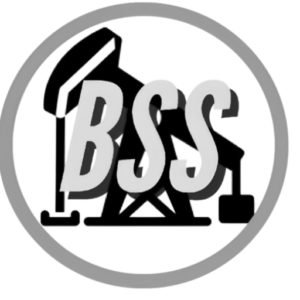Flowline Equipment in the Oil and Gas Industry
Table of Contents
The Complete Guide to Flowline Equipment in the Oil and Gas Industry

Blaze Sales and Service, a global leader in supplying flowline equipment, is proud to present this comprehensive guide to everything you need to know about flowline systems in the oil and gas industry. This guide will equip you with a deep understanding of flowline components, their importance, and best practices for installation, maintenance, and optimization.
I. Introduction
A. Understanding the Basics of Flowline Equipment
Flowline equipment refers to the network of pipes, valves, and other components that transport oil, gas, and water produced from wells to processing facilities. Efficient flowline systems are crucial for safe, reliable, and cost-effective operations in the oil and gas industry.
B. Importance of Efficient Flowline Systems
• Production Optimization: Efficient flowlines minimize pressure loss and ensure smooth transportation of fluids, maximizing production output.
• Cost Reduction: Optimized flowlines reduce energy consumption for transportation, leading to significant cost savings.
• Safety and Reliability: Properly designed, installed, and maintained flowlines minimize the risk of leaks, spills, and equipment failures, ensuring safe and reliable operations
C. Overview of Flowline Components
Flowline systems comprise various components, each playing a vital role:
• Flowline Pipe: The main conduit for transporting fluids. eg. Pup Joints.
• Valves and Fittings: Regulate flow, change direction, and isolate sections of the pipeline for maintenance.
• Manifolds: Combine multiple flowlines into a single line for efficient transportation.
• Chokes: Control the flow rate of fluids exiting the well.
II. Types of Flowline Equipment
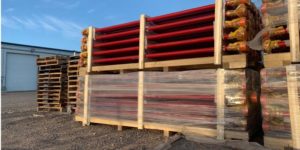
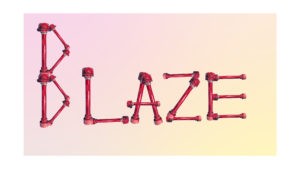
A. Flowline Pipe
1. Different Materials Used for Flowline Pipes:
- Carbon Steel: Cost-effective for low-pressure applications.
- Corrosion-Resistant Alloys (CRAs): Used for high-pressure, high-temperature environments or corrosive fluids.
- Composite Pipes: Lightweight and resistant to corrosion, ideal for subsea applications.
2. Importance of Pipe Size and Wall Thickness: Pipe size is determined by flow rate and pressure requirements. Wall thickness ensures the pipe can withstand internal and external pressure.
3. Considerations for Corrosion Resistance: Choosing the right pipe material and coatings is crucial to prevent corrosion, which can compromise pipe integrity and lead to leaks.
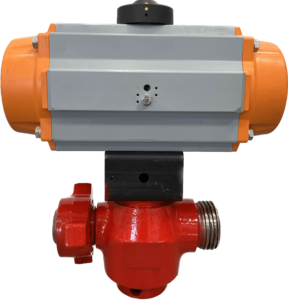

B. Valves and Fittings
o Valves control flow by opening, closing, or regulating fluid passage.
o Fittings change the direction of flow, connect pipes of different sizes, or provide access points for instruments.
Explore In-Depth coverage Here.

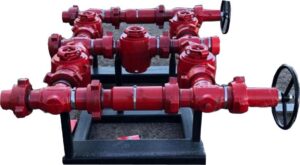
C. Manifolds and Chokes
1. Purpose of Manifolds and Chokes in Flowline Operations:
o Manifolds: Combine multiple flowlines into a single line, allowing for efficient gathering and transportation of fluids.
o Chokes: Control the flow rate of fluids exiting the well to manage pressure and optimize production.
2. Types of Manifolds and Chokes Used in the Oil and Gas Industry:
o Wellhead Manifolds: Combine flowlines from multiple wells at the wellhead.
o Production Manifolds: Combine flowlines from multiple wellhead manifolds for further processing.
o Bean Chokes: Use a fixed size opening to regulate flow.
o Adjustable Chokes: Allow for precise control of flow rate.
3. Importance of Proper Installation and Maintenance:
Proper installation and maintenance of manifolds and chokes are critical for ensuring their functionality and preventing production disruptions.
III. Installation and Maintenance of Flowline Equipment
A. Best Practices for Flowline
Installation
1. Pre-Installation Preparation and Safety Measures:
o Thorough site surveys to identify potential hazards and plan the pipeline route.
o Obtaining necessary permits and approvals from regulatory bodies.
o Implementing strict safety protocols for workers, including proper training and personal protective equipment (PPE).
2. Steps Involved in Flowline System Installation:
o Trenching and Excavation: Creating a path for the pipeline according to specifications.
o Pipe Stringing and Welding: Laying the pipes along the designated route and securely welding them together for a leak-proof connection.
o Lowering and Burial: Carefully lowering the pipeline into the trench and burying it for protection.
Case Study: Deepwater Flowline Installation
A major oil and gas company in the Gulf of Mexico needed to install a flowline system in deepwater (over 1,500 meters). Blaze Sales and Service provided a customized solution using high-strength composite pipes resistant to corrosion and capable of withstanding the immense pressure at such depths. Our team also collaborated with specialized installation vessels to ensure safe and precise placement of the flowline on the seabed.
B. Maintenance Strategies for Flowline Equipment
1. Routine Maintenance Checks and Inspections:
o Regular visual inspections of pipelines for signs of wear, corrosion, or leaks.
o Internal pipeline inspection using specialized tools like pigs (cleaning and inspection devices) to identify potential issues within the pipe.
o Monitoring pressure and flow rate data to detect any anomalies that might indicate problems.
2. Common Issues and Troubleshooting Tips for Flowline Systems:
o Corrosion: Regularly inspecting pipelines for corrosion and applying protective coatings or replacing sections as needed.
o Blockages: Utilizing pigs to clear blockages caused by debris buildup or internal pipe scaling.
o Leaks: Promptly identifying and repairing leaks to prevent environmental damage and production losses.
3. Importance of Training and Skill Development for Maintenance Personnel:
Investing in training programs for maintenance personnel ensures they possess the necessary skills and knowledge to effectively maintain flowline systems and identify potential problems early on.
C. Environmental Considerations in Flowline Operations
- Mitigating Environmental Risks Associated with Flowline Equipment:
- Employing spill prevention measures to minimize the risk of oil and gas leaks into the environment.
- Developing spill response plans for prompt and effective cleanup in case of accidents.
- Following strict regulations regarding waste disposal from pipeline maintenance activities.
- Compliance with Regulations and Standards:
Staying compliant with environmental regulations set by national and international bodies is crucial for responsible flowline operations.
- Implementing Sustainable Practices in Flowline Operations:
- Utilizing leak detection technologies to minimize potential environmental impact.
- Choosing eco-friendly materials for pipeline construction whenever possible.
- Following responsible waste management practices during pipeline maintenance.
IV. Enhancing Flowline Efficiency and Performance
A. Technologies and Innovations in Flowline Equipment
1. Automation and Remote Monitoring in Flowline Systems:
o Implementing automation systems for flow control and data collection.
o Utilizing remote monitoring technology to track pipeline performance and identify issues in real-time.
2. Advances in Flowline Design for Increased Efficiency:
o Developing flowline coatings that reduce friction and improve flow rates.
o Utilizing advanced pipeline modeling software to optimize flowline design and minimize pressure losses.
3. Benefits of Digitalization and Data Analytics in Flowline Operations:
o Real-time data analysis helps predict potential problems and optimize maintenance schedules.
o Digitalization allows for remote collaboration and improved communication between teams managing flowline systems.
Case Study: Utilizing Big Data for Flowline Optimization
An oil and gas company in the North Sea partnered with Blaze Sales and Service to implement a big data analytics platform for their flowline network. By analyzing sensor data from the pipelines, the company was able to identify and address minor inefficiencies before they became major problems. This proactive approach resulted in a significant improvement in flowline performance and production uptime.
B. Optimizing Flowline Operations
- Strategies for Improving Flowline Productivity:
- Regularly evaluating flowline performance and identifying areas for improvement.
- Optimizing flow rates to maximize production while minimizing energy consumption.
- Implementing preventive maintenance strategies to avoid downtime and production losses.
- Effective Communication and Collaboration Across Teams : Clear and consistent communication between production, maintenance,share and engineering teams is essential for efficient flowline operations.
- Sharing data and insights across departments allows for proactive problem-solving and better decision-making.
- Maximizing Flowline Performance Through Continuous Improvement:
- Adopting a culture of continuous improvement by regularly reviewing flowline performance data and implementing best practices.
- Investing in training and development programs for personnel to ensure they have the latest knowledge and skills for optimizing flowline operations.
C. Future Trends in Flowline Equipment
1. Emerging Technologies Shaping the Future of Flowline Operations:
o The use of artificial intelligence (AI) for predictive maintenance and real-time flow optimization.
o Development of self-healing pipeline materials that can autonomously repair small leaks.
o Increased adoption of digital twin technology for creating virtual models of flowline systems for improved design, operation, and maintenance.
2. Sustainability Initiatives and their Impact on Flowline Equipment:
o Focus on using recyclable materials in pipeline construction.
o Development of leak detection technologies with lower environmental impact.
o Designing flowline systems for reduced energy consumption during transportation.
3. The Role of Flowline Equipment in the Energy Transition:
o Adapting flowline systems to handle new forms of energy like captured carbon or hydrogen.
o Developing flowline infrastructure for offshore wind farms or geothermal energy projects.
V. Conclusion
A. Summary of Key Points Covered
This comprehensive guide has explored the various aspects of flowline equipment in the oil and gas industry. We covered the essential components, best practices for installation and maintenance, environmental considerations, and strategies for enhancing flowline efficiency and performance.
B. Importance of Flowline Equipment in the Oil and Gas Industry
Flowline equipment plays a critical role in ensuring safe, reliable, and efficient oil and gas production. By understanding the different components, proper maintenance practices, and the latest advancements in flowline technology, operators can optimize their flowline systems for maximum productivity and minimize environmental impact.
C. Recommendations for Implementing Effective Flowline Systems
• Partner with a reputable flowline equipment supplier like Blaze Sales and Service to ensure you have access to high-quality components and expert advice.
• Develop a comprehensive flowline management plan that includes installation, maintenance, and optimization strategies.
• Invest in training and skill development for your personnel to ensure they can effectively operate and maintain your flowline systems.
• Stay up-to-date on the latest advancements in flowline technology and consider implementing them to improve efficiency and sustainability.
FAQs
1. What is the purpose of flowline equipment in the oil and gas industry?
Flowline equipment transports oil, gas, and water produced from wells to processing facilities.
2. How can I choose the right flowline components for my operations?
Consider factors like pressure and temperature requirements, fluid compatibility, and ease of maintenance when selecting flowline components. Consulting with a flowline equipment supplier like Blaze Sales and Service can help you make informed decisions.
3. What are some common challenges faced in maintaining flowline equipment?
Corrosion, blockages, and leaks are some of the most common challenges faced in maintaining flowline systems.
4. How can technology improve the efficiency of flowline systems?
Automation, remote monitoring, big data analytics, and digital twin technology can all contribute to improved flowline efficiency.
5. What are some upcoming trends to watch for in flowline equipment?
The use of AI, self-healing materials, and digital twins are some of the emerging trends shaping the future of flowline equipment.
By implementing these recommendations and staying informed about the latest advancements, you can ensure your flowline systems operate efficiently, reliably, and sustainably for years to come.
Contact Blaze Sales and Service, your trusted partner for all your flowline equipment needs. We offer a comprehensive selection of high-quality flowline components and expert advice to ensure your operations run smoothly and efficiently.
Thank You

